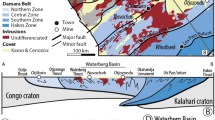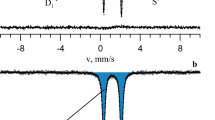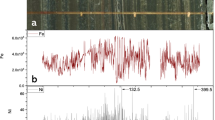Abstract
Replying to C. T. Reinhard & N. J. Planavsky Nature 474, doi:10.1038/nature09959 (2011); N. Dauphas & J. F. Kasting Nature 474 doi:10.1038/nature09960 (2011); C. Goldblatt & K. Zahnle Nature 474 doi:10.1038/nature09961 (2011)
Reinhard and Planavsky1 and Dauphas and Kasting2 question whether the formation of Fe2+/Fe3+-rich sediments and the preservation of magnetite in banded iron formations (BIFs) constrains atmospheric  . Goldblatt and Zahnle3 question whether reduced albedo in combination with a slightly increased greenhouse effect could compensate for the reduced luminosity of the faint young Sun. Reinhard and Planavsky1 and Dauphas and Kasting2 suggest that BIF mineralogy is solely controlled by diagenetic and metamorphic processes decoupled from ocean–atmosphere chemistry. We focus on the persistent preservation of magnetite in all Archean BIFs, and of magnetite and siderite in many BIFs4, and estimate the partial pressure of CO2 during the Archean (
. Goldblatt and Zahnle3 question whether reduced albedo in combination with a slightly increased greenhouse effect could compensate for the reduced luminosity of the faint young Sun. Reinhard and Planavsky1 and Dauphas and Kasting2 suggest that BIF mineralogy is solely controlled by diagenetic and metamorphic processes decoupled from ocean–atmosphere chemistry. We focus on the persistent preservation of magnetite in all Archean BIFs, and of magnetite and siderite in many BIFs4, and estimate the partial pressure of CO2 during the Archean ( ) using the least number of assumptions concerning unconstrained parameters. Our conclusions5 are not undermined by any geochemical data that support high
) using the least number of assumptions concerning unconstrained parameters. Our conclusions5 are not undermined by any geochemical data that support high  .
.
Similar content being viewed by others
Enjoying our latest content?
Log in or create an account to continue
- Access the most recent journalism from Nature's award-winning team
- Explore the latest features & opinion covering groundbreaking research
or
References
Reinhard, C. T. & Planavsky, N. J. Mineralogical constraints on Precambrian p CO 2 . Nature 474 10.1038/nature09959 (this issue).
Dauphas, N. & Kasting, J. F. Low in the pore water, not in the Archean air. Nature 474 10.1038/nature09960 (this issue).
Goldblatt, C. & Zahnle, K. Faint young Sun paradox remains. Nature 474, 10.1038/nature09961 (this issue).
Klein, C. Some Precambrian banded iron-formations (BIFs) from around the world: their age, geologic setting, mineralogy, metamorphism, geochemistry, and origin. Am. Mineral. 90, 1473–1499 (2005)
Rosing, M. T., Bird, D. K., Sleep, N. H. & Bjerrum, C. J. No climate paradox under the faint early Sun. Nature 464, 744–747 (2010)
Kocar, B. D. & Fendorf, S. Thermodynamic constraints on reductive reactions influencing the biogeochemistry of arsenic in soils and sediments. Environ. Sci. Technol. 43, 4871–4877 (2009)
Hansel, C. M. et al. Secondary mineralization pathways induced by dissimilatory iron reduction of ferrihydrite under advective flow. Geochim. Cosmochim. Acta 67, 2977–2992 (2003)
Behrends, T. & Van Cappellen, P. Transformation of hematite into magnetite during dissimilatory iron reduction—conditions and mechanisms. Geomicrobiol. J. 24, 403–416 (2007)
Lovley, D. R. & Goodwin, S. Hydrogen concentrations as an indicator of the predominant terminal electron-accepting reactions in aquatic sediments. Geochim. Cosmochim. Acta 52, 2993–3003 (1988)
Heimann, A. et al. Fe, C, and O isotope compositions of banded iron formation carbonates demonstrate a major role for dissimilatory iron reduction in ∼2.5 Ga marine environments. Earth Planet. Sci. Lett. 294, 8–18 (2010)
Boudreau, B. P., Canfield, D. E. & Mucci, A. Early diagenesis in a marine sapropel, Mangrove Lake, Bermuda. Limnol. Oceanogr. 37, 1738–1753 (1992)
Becker, R. H. & Clayton, R. N. Carbon isotopic evidence for origin of a banded iron-formation in Western Australia. Geochim. Cosmochim. Acta 36, 577–595 (1972)
Konhauser, K. O., Newman, D. K. & Kappler, A. The potential significance of microbial Fe(III) reduction during deposition of Precambrian banded iron formations. Geobiology 3, 167–177 (2005)
Wolery, T. J. EQ3nr. A Computer Program for Geochemical Aqueous Speciation Solubility Calculations: Theoretical Manual, User's Guide and Related Documentation. Version 7.0. (Lawrence Livermore National Laboratory, 1991)
Friend, C. R. L., Nutman, A. P., Bennett, V. C. & Norman, M. D. Seawater-like trace element signatures (REE+Y) of Eoarchaean chemical sedimentary rocks from southern West Greenland, and their corruption during high-grade metamorphism. Contrib. Mineral. Petrol. 155, 229–246 (2008)
Bjerrum, C. J. & Canfield, D. E. Ocean productivity before about 1.9 Gyr ago limited by phosphorus adsorption onto iron oxides. Nature 417, 159–162 (2002)
Canfield, D. E., Rosing, M. T. & Bjerrum, C. Early anaerobic metabolisms. Phil. Trans. R. Soc. Lond. B 361, 1819–1834 (2006)
Andreae, M. O. & Rosenfeld, D. Aerosol-cloud-precipitation interactions. Part 1. The nature and sources of cloud-active aerosols. Earth Sci. Rev. 89, 13–41 (2008)
Kaufman, Y. J., Koren, I., Remer, L. A., Rosenfeld, D. & Rudich, Y. The effect of smoke, dust, and pollution aerosol on shallow cloud development over the Atlantic Ocean. Proc. Natl Acad. Sci. USA 102, 11207–11212 (2005)
Goldblatt, C. & Zahnle, K. J. Clouds and the faint young Sun paradox. Clim. Past Discuss. 6, 1163–1207 (2010)
Kump, L. R. & Pollard, D. Amplification of Cretaceous warmth by biological cloud feedbacks. Science 320, 195 (2008)
Author information
Authors and Affiliations
Contributions
All authors contributed equally to this Reply.
Corresponding author
Rights and permissions
About this article
Cite this article
Rosing, M., Bird, D., Sleep, N. et al. Rosing, Bird, Sleep & Bjerrum reply. Nature 474, E1 (2011). https://doi.org/10.1038/nature09962
Published:
Issue date:
DOI: https://doi.org/10.1038/nature09962
This article is cited by
-
Origin and evolution of the atmospheres of early Venus, Earth and Mars
The Astronomy and Astrophysics Review (2018)
-
Fossil raindrops and ancient air
Nature (2012)



